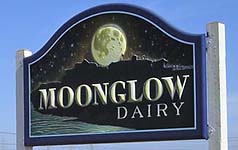
Birding at
MOONGLOW DAIRY
Moss Landing
|
|
For avid birders there may be no better spot in the entire Elkhorn Slough vicinity than the privately owned MoonGlow Dairy.
I was first able to arrange birding access in the late 1970s, and the
owners — Louis & Carol Calcagno — have welcomed birders ever since.
Because I "discovered" this site and arranged access over 30 years ago
and have birded here regularly ever since, I feel a special
responsibility for birders' behavior here. Indeed, this web page is
only posted with the permission of the Calcagnos, and birders must
remember that access could be closed at any time. You have no "rights"
to be here —we are very lucky to be welcome at present.
The
main road into MoonGlow, described below, is now controlled by an
electronic gate. This gate is usually open, and birders are welcome to
enter. Even if the gate were to close during your visit, it would
automatically open as you drove out. However, there are times now when
the gate is closed and access is not available. Louis Calcagno has
advised me that theft and vandalism in recent years has caused the
Dairy to reduce access at certain times. Obviously, birders are not
involved in these illegal activities, but sometimes we, like the
owners, are victims of circumstance. Please be understanding that the
Dairy is no longer always open.
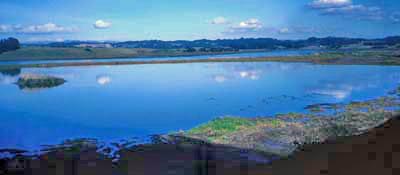 MoonGlow
Dairy is located 1.2 miles east of Highway 1 in Moss Landing off Dolan
Road (Dolan Rd. goes inland from Hwy 1 at the Moss Landing power
plant). There is a large sign and one turns left (north) on a dirt road
into the dairy. In about a half-mile you reach the first cattle pens.
Turn left here and continue as far as you can, turning right at the
end. This dirt road ends in a hundred yards in a lot overlooking the
freshwater pond and Elkhorn Slough. Your view is similar to that shown
in the photo (right) when the pond is full, but the
water level in the freshwater pond varies seasonally. When the pond is
low, it looks more like the shot above. Cattle pens will be on your right, and a huge eucalyptus grove (see photo below) is immediately on your left. MoonGlow
Dairy is located 1.2 miles east of Highway 1 in Moss Landing off Dolan
Road (Dolan Rd. goes inland from Hwy 1 at the Moss Landing power
plant). There is a large sign and one turns left (north) on a dirt road
into the dairy. In about a half-mile you reach the first cattle pens.
Turn left here and continue as far as you can, turning right at the
end. This dirt road ends in a hundred yards in a lot overlooking the
freshwater pond and Elkhorn Slough. Your view is similar to that shown
in the photo (right) when the pond is full, but the
water level in the freshwater pond varies seasonally. When the pond is
low, it looks more like the shot above. Cattle pens will be on your right, and a huge eucalyptus grove (see photo below) is immediately on your left.
Park only along the edge of this eucalyptus grove.
|
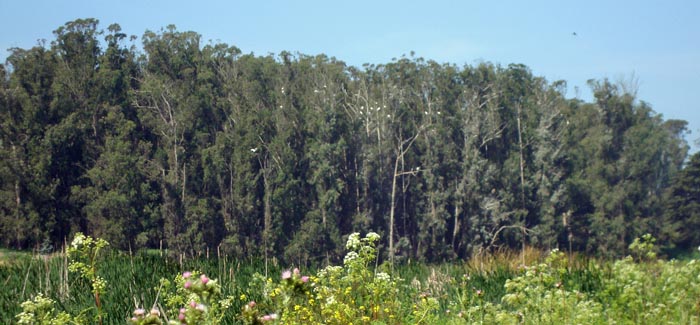 The
eucalyptus grove is now owned by Elkhorn Slough Foundation and is also
open to birders. There are wide dirt tracks through the grove, and
birding for landbird migrants can be good in fall and spring migrations
at times. In recent years the slough-side of the grove is a very active
heronry for Great Blue Heron, Great Egret, and hundreds of
Double-crested Cormorant (photo, left). The
eucalyptus grove is now owned by Elkhorn Slough Foundation and is also
open to birders. There are wide dirt tracks through the grove, and
birding for landbird migrants can be good in fall and spring migrations
at times. In recent years the slough-side of the grove is a very active
heronry for Great Blue Heron, Great Egret, and hundreds of
Double-crested Cormorant (photo, left).
There are
times when you can walk on the road overlooking the big pond (we call
it pond #1) to a nice overlook to the east, but sometimes dairy run-off
prevents that by a muddy dribble across the road, so be aware of that. |
 You should be aware that MoonGlow looks and smells like a dairy (right), and there are lots of flies. Don't visit if you don't like these conditions. You should be aware that MoonGlow looks and smells like a dairy (right), and there are lots of flies. Don't visit if you don't like these conditions.
Here are the absolutely critical rules that you must follow
to bird at MoonGlow Dairy. They are actually just common sense and good
manners, but I am amazed that sometimes birdwatchers desperate to see
some rare bird will forget their manners:
- Park only along the eucalyptus grove (unless you are a long-time local birder who is permitted to park at another viewpoint).
- In any event, you must park AWAY FROM THE CATTLE TROUGHS.
The cows are fed daily by a truck that goes along the troughs. If you
park next the troughs you would block the feed truck. Some birders have
thoughtlessly done this in the past — NEVER PARK NEAR A CATTLE TROUGH OR CATTLE PEN.
- Also never leave your vehicle where it will block any of the roads.
- Drive
slowly on the dirt roads — It doesn't matter that you've been driving
fast freeways for hours to chase some rarity. You are now on private
property through the good graces of some really nice people — so be
courteous, damn it.
- Drive so you do NOT raise a cloud of dust!
- It goes without saying that you should take nothing but photographs, and leave nothing but footprints.
- Stay
away from the residences. Be aware of the dairy operations, and always
stay out of the way of the workers. This is all that has been asked of
us -- surely simple enough.
Also be aware that dirt roads get very muddy in wet weather, and therefore this is not a spot to visit in wet conditions. Stay out when the roads are wet.
The mud here is very thick and sticky; you don't want to ever risk
getting stuck. But visits in summer & fall are usually dry (and
dusty).
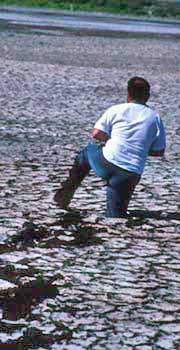 I
would also add from sad experience (right; photo Sep 1979 by M. J.
Lippsmeyer) that you should not try to walk out into the drying ponds
to get better views or photos. What looks like dry muck is actually a
thin dry crust over a wet green bog. Basically it is watery cow dung
with a dry crust. I had to throw these pants away (and I didn't get the
photos of the mystery stint either). I
would also add from sad experience (right; photo Sep 1979 by M. J.
Lippsmeyer) that you should not try to walk out into the drying ponds
to get better views or photos. What looks like dry muck is actually a
thin dry crust over a wet green bog. Basically it is watery cow dung
with a dry crust. I had to throw these pants away (and I didn't get the
photos of the mystery stint either).
Here is what you may do:
- Scope
the freshwater pond and the Slough from the heights overlooking the
pond. You can walk from the eucalyptus grove along a dirt road up by
several cattle pens for fabulous views of the Slough.
- The
tidal Elkhorn Slough is full of birds, and with a scope you can work on
waders, gulls, terns, ducks, grebes (both Western & Clark's regular
just here), and occasionally a rare alcid. The weedy hemlock next to
the road, and above the ponds, has Allen's Hummingbirds in spring, and
Yellow Warblers in fall, plus an autumn chance for Willow Flycatcher or
Palm Warbler.
- Walk the levee that starts at
the eucalyptus grove, goes around the big freshwater pond (which we
call "pond #1") and heads upslough along the edge of Elkhorn Slough
itself. Pond #1 has held some exceptional birds over the years, and the
edge of the Slough adjacent to that pond has had Bar-tailed Godwit,
Franklin's Gull, Least Tern and much more. The freshwater pond #1 is
regularly visited in fall by Red-necked & Wilson's Phalaropes and
Pectoral, Baird's, and Semipalmated Sandpipers (but the latter is rare
and should not be confused with the many Least and Western Sandpipers
present). In good Pectoral years a few Sharp-tailed Sandpipers have
occurred, and Ruff and other vagrants are semi-regular as rarities.
This freshwater pond is kept full during the winter/spring/summer but
is drawn down during the early fall to prepare it for the next winter's
rains. This management creates the wonderful shorebird habitat in
September-October.
- The levee between pond
#1 and Elkhorn Slough continues inland past a variably wet reedy area
(Bobolink, rails) to pond #2 which is a much smaller and reedy-edged
pond that often has ducks, shorebirds, and phalaropes (in season). The
dike (a broad dirt road but which grows low weeds) ends at a wooden
fence from which you may view pond #3 to the east (pond #3 is not owned
by MoonGlow Dairy, so we have no access beyond this viewpoint). Pond #3
is often filled with water and ducks. In fall 1999 it was daily visited
off-and-on by a White-winged Tern for two months; many other rarities
have occurred over the years.
- The cattle
pens of the dairy hold flocks of Tricolored Blackbirds from at least
July into April (in May-June the "Trikes" are at breeding colonies).
These flocks often have a few Yellow-headed Blackbirds in May and in
early fall; in late fall-winter the pens sometimes have Cattle Egrets.
Check the mucky cattle pens which have held rare blackbirds (including
Great-tailed Grackle once) and golden-plovers in fall.
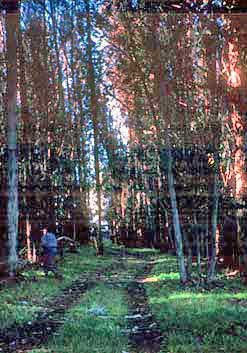 Finally,
there is a large and old eucalyptus grove that is bisected by several
rarely-used old roads (photo left). While eucalyptus are non-native and
usually not particularly good for birds, this grove is an exception. It
was planted early in the 20th century for wood and a windbreak, and was
last harvested 50-60 years ago. It is now an "old-growth" eucalypt
grove that has created a habitat of tall trees with shady canopy and
little undergrowth. In this aspect it mimics the characteristics of a
redwood grove and, remarkably, that redwood-grove specialist — Pacific
Wren — is now resident. This phenomena is recent and was not known
during the Monterey Breeding Bird Atlas (Roberson & Tenney 1993).
Dan Singer, Bob Tintle & I discovered the first fledgling here 30
Apr 1994, and they have nested successfully every year since. Their
beautiful songs fill the grove in spring/summer. Pacific-slope
Flycatcher, Brown Creeper, Downy Woodpecker, and Chestnut-backed
Chickadees also nest. Allen's Hummingbirds are conspicuous Feb-May.
House Finch, American Goldfinch, and Pine Siskin vocalizations are
constantly heard. In fall migration, the northern and eastern edge of
the grove often harbor interesting landbird migrants. Some of these
appear in the Elkhorn Slough vagrant page (click below). Flocks of
Yellow & Wilson's Warblers in September give way to many
Yellow-rumpeds in October, but watch especially for vagrant warblers
and Empidonax flycatchers. Finally,
there is a large and old eucalyptus grove that is bisected by several
rarely-used old roads (photo left). While eucalyptus are non-native and
usually not particularly good for birds, this grove is an exception. It
was planted early in the 20th century for wood and a windbreak, and was
last harvested 50-60 years ago. It is now an "old-growth" eucalypt
grove that has created a habitat of tall trees with shady canopy and
little undergrowth. In this aspect it mimics the characteristics of a
redwood grove and, remarkably, that redwood-grove specialist — Pacific
Wren — is now resident. This phenomena is recent and was not known
during the Monterey Breeding Bird Atlas (Roberson & Tenney 1993).
Dan Singer, Bob Tintle & I discovered the first fledgling here 30
Apr 1994, and they have nested successfully every year since. Their
beautiful songs fill the grove in spring/summer. Pacific-slope
Flycatcher, Brown Creeper, Downy Woodpecker, and Chestnut-backed
Chickadees also nest. Allen's Hummingbirds are conspicuous Feb-May.
House Finch, American Goldfinch, and Pine Siskin vocalizations are
constantly heard. In fall migration, the northern and eastern edge of
the grove often harbor interesting landbird migrants. Some of these
appear in the Elkhorn Slough vagrant page (click below). Flocks of
Yellow & Wilson's Warblers in September give way to many
Yellow-rumpeds in October, but watch especially for vagrant warblers
and Empidonax flycatchers.
In all, over 250 species have occurred at or been viewed from MoonGlow Dairy. Check out the constantly updated and evolving list and bar graph from eBird. |
 I
wish to thank Louis & Carol Calcagno for their hospitality in
permitting birder access here, and for their management of the
freshwater pond in ways that provide outstanding shorebird habitat in
fall, and fine duck habitat in winter. The Calcagnos have twice
received American Birding Association commendations: in 1990 for the
White Wagtail event and in 1999 for the White-winged Tern episode. In
the photo (right) Louis & Carol Calcagno received their 2000 ABA
commendation from Rita Carratello, local Audubon newsletter editor. The
famous "White-winged Tern pond" is visible directly behind them (photo
30 Sep 2000; © 2000 D. Roberson). The Calcagnos were also honored
by the local Monterey Peninsula Audubon Society in 1985 for their
graciousness during the Little Stint. In each situation MoonGlow Dairy
hosted hundreds, maybe thousands, of birdwatchers. [Louis Calcagno has
also served on the California Coastal Commission and is currently on
the Monterey County Board of Supervisors.] I
wish to thank Louis & Carol Calcagno for their hospitality in
permitting birder access here, and for their management of the
freshwater pond in ways that provide outstanding shorebird habitat in
fall, and fine duck habitat in winter. The Calcagnos have twice
received American Birding Association commendations: in 1990 for the
White Wagtail event and in 1999 for the White-winged Tern episode. In
the photo (right) Louis & Carol Calcagno received their 2000 ABA
commendation from Rita Carratello, local Audubon newsletter editor. The
famous "White-winged Tern pond" is visible directly behind them (photo
30 Sep 2000; © 2000 D. Roberson). The Calcagnos were also honored
by the local Monterey Peninsula Audubon Society in 1985 for their
graciousness during the Little Stint. In each situation MoonGlow Dairy
hosted hundreds, maybe thousands, of birdwatchers. [Louis Calcagno has
also served on the California Coastal Commission and is currently on
the Monterey County Board of Supervisors.] |
Literature cited:
Roberson, D., and C. Tenney, eds. 1993. Atlas of the Breeding Birds of
Monterey County, California. Monterey Pen. Audubon Soc., Carmel, CA.
GO BACK TO ELKHORN SLOUGH/MOSS LANDING PAGE
GO TO PAGE ON "TOP TEN BIRDS" FROM ELKHORN SLOUGH & VICINITY
many of these are from Moonglow Dairy! [ below: birders looking at a Little Stint in drying pond #1, Sep 1985 ] |
|
|

 I
wish to thank Louis & Carol Calcagno for their hospitality in
permitting birder access here, and for their management of the
freshwater pond in ways that provide outstanding shorebird habitat in
fall, and fine duck habitat in winter. The Calcagnos have twice
received American Birding Association commendations: in 1990 for the
White Wagtail event and in 1999 for the White-winged Tern episode. In
the photo (right) Louis & Carol Calcagno received their 2000 ABA
commendation from Rita Carratello, local Audubon newsletter editor. The
famous "White-winged Tern pond" is visible directly behind them (photo
30 Sep 2000; © 2000 D. Roberson). The Calcagnos were also honored
by the local Monterey Peninsula Audubon Society in 1985 for their
graciousness during the Little Stint. In each situation MoonGlow Dairy
hosted hundreds, maybe thousands, of birdwatchers. [Louis Calcagno has
also served on the California Coastal Commission and is currently on
the Monterey County Board of Supervisors.]
I
wish to thank Louis & Carol Calcagno for their hospitality in
permitting birder access here, and for their management of the
freshwater pond in ways that provide outstanding shorebird habitat in
fall, and fine duck habitat in winter. The Calcagnos have twice
received American Birding Association commendations: in 1990 for the
White Wagtail event and in 1999 for the White-winged Tern episode. In
the photo (right) Louis & Carol Calcagno received their 2000 ABA
commendation from Rita Carratello, local Audubon newsletter editor. The
famous "White-winged Tern pond" is visible directly behind them (photo
30 Sep 2000; © 2000 D. Roberson). The Calcagnos were also honored
by the local Monterey Peninsula Audubon Society in 1985 for their
graciousness during the Little Stint. In each situation MoonGlow Dairy
hosted hundreds, maybe thousands, of birdwatchers. [Louis Calcagno has
also served on the California Coastal Commission and is currently on
the Monterey County Board of Supervisors.] 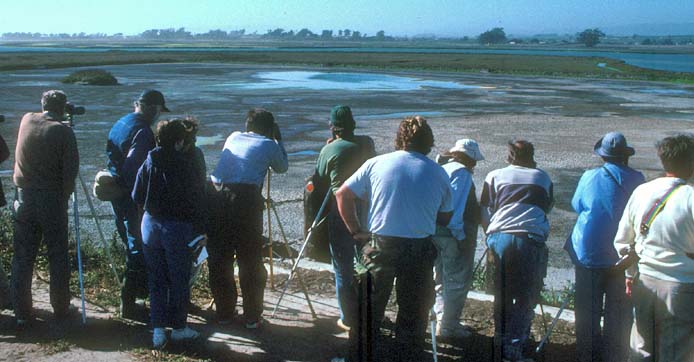

 MoonGlow
Dairy is located 1.2 miles east of Highway 1 in Moss Landing off Dolan
Road (Dolan Rd. goes inland from Hwy 1 at the Moss Landing power
plant). There is a large sign and one turns left (north) on a dirt road
into the dairy. In about a half-mile you reach the first cattle pens.
Turn left here and continue as far as you can, turning right at the
end. This dirt road ends in a hundred yards in a lot overlooking the
freshwater pond and Elkhorn Slough. Your view is similar to that shown
in the photo (right) when the pond is full, but the
water level in the freshwater pond varies seasonally. When the pond is
low, it looks more like the shot above. Cattle pens will be on your right, and a huge eucalyptus grove (see photo below) is immediately on your left.
MoonGlow
Dairy is located 1.2 miles east of Highway 1 in Moss Landing off Dolan
Road (Dolan Rd. goes inland from Hwy 1 at the Moss Landing power
plant). There is a large sign and one turns left (north) on a dirt road
into the dairy. In about a half-mile you reach the first cattle pens.
Turn left here and continue as far as you can, turning right at the
end. This dirt road ends in a hundred yards in a lot overlooking the
freshwater pond and Elkhorn Slough. Your view is similar to that shown
in the photo (right) when the pond is full, but the
water level in the freshwater pond varies seasonally. When the pond is
low, it looks more like the shot above. Cattle pens will be on your right, and a huge eucalyptus grove (see photo below) is immediately on your left.  The
eucalyptus grove is now owned by Elkhorn Slough Foundation and is also
open to birders. There are wide dirt tracks through the grove, and
birding for landbird migrants can be good in fall and spring migrations
at times. In recent years the slough-side of the grove is a very active
heronry for Great Blue Heron, Great Egret, and hundreds of
Double-crested Cormorant (photo, left).
The
eucalyptus grove is now owned by Elkhorn Slough Foundation and is also
open to birders. There are wide dirt tracks through the grove, and
birding for landbird migrants can be good in fall and spring migrations
at times. In recent years the slough-side of the grove is a very active
heronry for Great Blue Heron, Great Egret, and hundreds of
Double-crested Cormorant (photo, left). You should be aware that MoonGlow looks and smells like a dairy (right), and there are lots of flies. Don't visit if you don't like these conditions.
You should be aware that MoonGlow looks and smells like a dairy (right), and there are lots of flies. Don't visit if you don't like these conditions.  I
would also add from sad experience (right; photo Sep 1979 by M. J.
Lippsmeyer) that you should not try to walk out into the drying ponds
to get better views or photos. What looks like dry muck is actually a
thin dry crust over a wet green bog. Basically it is watery cow dung
with a dry crust. I had to throw these pants away (and I didn't get the
photos of the mystery stint either).
I
would also add from sad experience (right; photo Sep 1979 by M. J.
Lippsmeyer) that you should not try to walk out into the drying ponds
to get better views or photos. What looks like dry muck is actually a
thin dry crust over a wet green bog. Basically it is watery cow dung
with a dry crust. I had to throw these pants away (and I didn't get the
photos of the mystery stint either).  Finally,
there is a large and old eucalyptus grove that is bisected by several
rarely-used old roads (photo left). While eucalyptus are non-native and
usually not particularly good for birds, this grove is an exception. It
was planted early in the 20th century for wood and a windbreak, and was
last harvested 50-60 years ago. It is now an "old-growth" eucalypt
grove that has created a habitat of tall trees with shady canopy and
little undergrowth. In this aspect it mimics the characteristics of a
redwood grove and, remarkably, that redwood-grove specialist — Pacific
Wren — is now resident. This phenomena is recent and was not known
during the Monterey Breeding Bird Atlas (Roberson & Tenney 1993).
Dan Singer, Bob Tintle & I discovered the first fledgling here 30
Apr 1994, and they have nested successfully every year since. Their
beautiful songs fill the grove in spring/summer. Pacific-slope
Flycatcher, Brown Creeper, Downy Woodpecker, and Chestnut-backed
Chickadees also nest. Allen's Hummingbirds are conspicuous Feb-May.
House Finch, American Goldfinch, and Pine Siskin vocalizations are
constantly heard. In fall migration, the northern and eastern edge of
the grove often harbor interesting landbird migrants. Some of these
appear in the Elkhorn Slough vagrant page (click below). Flocks of
Yellow & Wilson's Warblers in September give way to many
Yellow-rumpeds in October, but watch especially for vagrant warblers
and Empidonax flycatchers.
Finally,
there is a large and old eucalyptus grove that is bisected by several
rarely-used old roads (photo left). While eucalyptus are non-native and
usually not particularly good for birds, this grove is an exception. It
was planted early in the 20th century for wood and a windbreak, and was
last harvested 50-60 years ago. It is now an "old-growth" eucalypt
grove that has created a habitat of tall trees with shady canopy and
little undergrowth. In this aspect it mimics the characteristics of a
redwood grove and, remarkably, that redwood-grove specialist — Pacific
Wren — is now resident. This phenomena is recent and was not known
during the Monterey Breeding Bird Atlas (Roberson & Tenney 1993).
Dan Singer, Bob Tintle & I discovered the first fledgling here 30
Apr 1994, and they have nested successfully every year since. Their
beautiful songs fill the grove in spring/summer. Pacific-slope
Flycatcher, Brown Creeper, Downy Woodpecker, and Chestnut-backed
Chickadees also nest. Allen's Hummingbirds are conspicuous Feb-May.
House Finch, American Goldfinch, and Pine Siskin vocalizations are
constantly heard. In fall migration, the northern and eastern edge of
the grove often harbor interesting landbird migrants. Some of these
appear in the Elkhorn Slough vagrant page (click below). Flocks of
Yellow & Wilson's Warblers in September give way to many
Yellow-rumpeds in October, but watch especially for vagrant warblers
and Empidonax flycatchers.